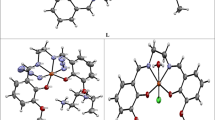Abstract
ABNORMALLY large differences in solubility and volatility between isomers of some disubstituted benzene derivatives have been explained by Dr. N. V. Sidgwick as arising from the presence of chelate rings in the anomalous compounds. These rings are considered to be formed between ortho substituents and usually to contain six atoms, one of which is hydrogen situated between two oxygen atoms. The ease with which such rings can be ruptured has prevented a demonstration of the phenomenon by the usual methods of organic chemistry. In the course of a quantitative study of the infra-red absorption coefficients of a series of organic molecules, which is in progress in this laboratory1, an apparently specific behaviour has been found for this type of chelated compound.
This is a preview of subscription content, access via your institution
Access options
Subscribe to this journal
Receive 51 print issues and online access
$199.00 per year
only $3.90 per issue
Buy this article
- Purchase on Springer Link
- Instant access to full article PDF
Prices may be subject to local taxes which are calculated during checkout
Similar content being viewed by others
References
J. Amer. Chem. Soc., 55, 3574; 1933.
J. Chem. Soc., 123, 2819; 1923.
“The Electronic Theory of Valency” (London, 1929), p. 240.
Ref. 3, p. 245.
Author information
Authors and Affiliations
Rights and permissions
About this article
Cite this article
HILBERT, G., WULF, O., HENDRICKS, S. et al. A Spectroscopic Method for Detecting some Forms of Chelation. Nature 135, 147–148 (1935). https://doi.org/10.1038/135147b0
Issue Date:
DOI: https://doi.org/10.1038/135147b0
This article is cited by
-
Quantitative analysis of clay minerals and their admixtures
Contributions to Mineralogy and Petrology (1966)
-
Raman effect and hydrogen bonds
Proceedings of the Indian Academy of Sciences - Section A (1942)
-
Nature of the Cyclol Bond
Nature (1939)
-
The hydroxyl frequency in the Raman spectra of acids and acid salts
Proceedings of the Indian Academy of Sciences - Section A (1938)
-
The O-H Raman Frequency in Inorganic Acids
Nature (1937)
Comments
By submitting a comment you agree to abide by our Terms and Community Guidelines. If you find something abusive or that does not comply with our terms or guidelines please flag it as inappropriate.



